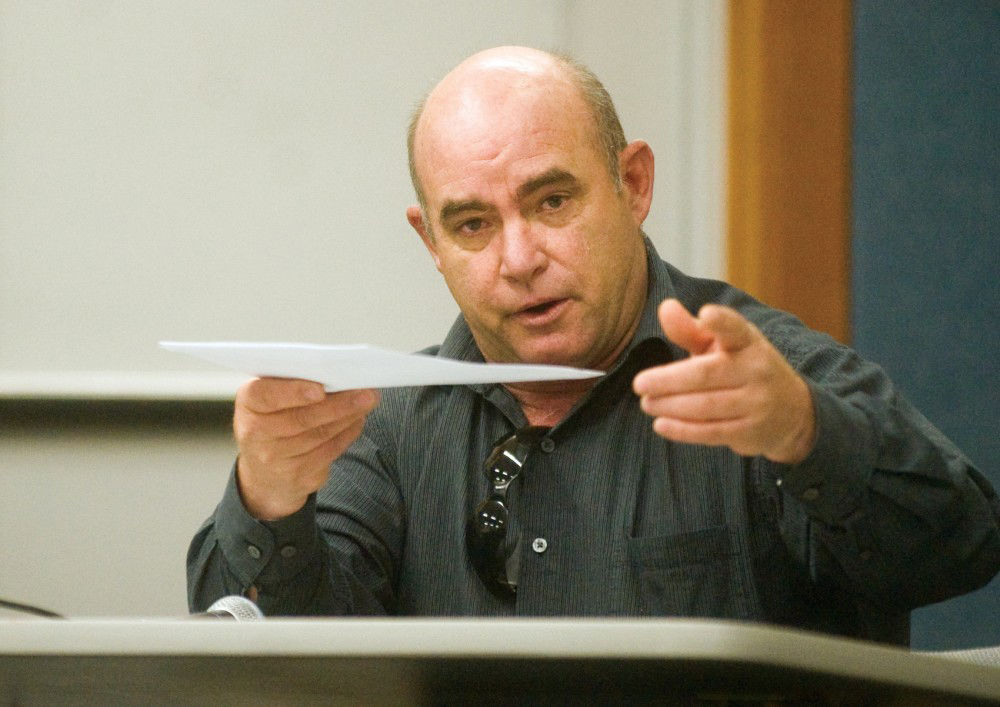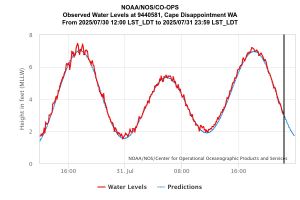Lady Cecilia’s final moments take shape
Published 4:00 pm Monday, November 26, 2012

- <p>Kurt Ward, of FDS Marine International, who helped locate and examine the wreck of the fishing vessel Lady Cecelia, shares his theory Monday on what may have led to the sinking of the boat in March.</p>
WARRENTON Hearings on the sunken fishing vessel Lady Cecelia had stalled since April, when the U.S. Coast Guard brought in the vessels owner, former captains and deckhands, marine examiners, boat mechanics and family to gather information on the boat, the crew and their situation before and during their final fishing trip.
Trending
On Sept. 9, the U.S. Coast Guard and FDS Marine International, LLC, found the wreck of the Lady Cecelia lodged in the mud 317 feet underwater, 20 miles west of the entrance of Willapa Bay, restarting the hearings, with interested parties anxious to see footage from the Remotely Operated Vehicle (ROV) that surveyed the sunken vessel.
On Monday, the Coast Guard Formal Board of Investigation started the second round of Lady Cecelia hearings at Camp Rilea. The unveiled footage of the vessel introduced errant crab pot lines as a potentially key variable in its and the crews demise.
The Lady Cecelia sank March 10 in the Pacific Ocean 20 miles west of Leadbetter Point, taking with it skipper Dave Nichols, 43, of Astoria; Jason Bjaranson, 38, of Warrenton; deckhand Luke Jensen, 22, of Ilwaco; and fisheries observer Christopher Langel, 25, of Kaukauna, Wis.
Trending
There were crab pots that were pulled down for some reason, said Kurt Ward, a co-owner of FDS who helped the ROV operator navigate. As the ROV approached the boat, he said it became entangled in the lines 40 to 60 feet from the bottom. A diver eventually had to cut the ROV free from the equipment lines, causing damage to its tether.
He said they identified what appeared to be a crab pot line coming up from the rudder of the Lady Cecelia. Three crab pot buoys would eventually be cut from the Lady Cecelia, two logged into evidence and one lost.
What Ward and the ROV operator also didnt see on the port side of the Lady Cecelia was a flopper stopper, or stabilizer strung out over the side of the vessel using guy lines to reduce rolling with a metallic fin submerged in the water. The starboard side had its stabilizer.
The vessel was in good condition, said Ward, adding that it was very strange to have a cluster of crab pot buoys underwater.
Lt. Anthony Hillenbrand, the lead investigator, would later introduce the fishing term flower pots as a possibility for what the Lady Cecelia got tangled up in. It means a group of crab pot lines tangled and wound up during a storm or surge and appearing like flower from the top.
When asked his informed guess as to what might have happened, Ward, a long-time fisherman, focused on the crab pot lines his own ROV had become entangled in.
He said that, in his opinion, the vessel, which was rumored to have near its maximum load of fish, might have ran into multiple crab pot lines, started listing to the left while caught on the lines, catastrophically rolled the opposite direction when the port side stabilizer finally snapped off, and capsized in a quick roll.
With the load they had, the sinking was instant, said Ward.
Whos buoys were those?
Robert Brisco, a Washington-based crab fisherman with a 500-pot limit, had leased his gear out from a fellow fisherman and gone out between mid-January and mid-May, mostly between Leadbetter Point and the Westport (Wash.) Bar.
The buoys cut free from above the Lady Cecelia were registered to Brisco, who said hed lost 44 crab pots this last season, including some before the Lady Cecelia sank.
The pots get lost because someone drags them off, he said during his telephone testimony. We had a problem last year with shrimp trawlers.
Brisco broached the possibility that the crab pot lines could be from previous fishing seasons. The crab pot lines, he said, could be staggered anywhere from 200 yards to 2 miles apart, often in strings of about 50 running parallel to the coastline. They are topped with colorful buoys, the design registered to a certain fishers license number to keep track of their equipment.
I work with fishermen to make their logs more accurate, said Carol Henry of the Washington Department of Fish and Wildlife, brought in to testify about Briscos logs.
She said the state of Washington uses a derelict gear program to track lost pots, providing fishers and affidavit to fill out denoting the location of lost gear. Fishers are only allowed to recover their own gear, she added.
Henry said flower pots are a fairly common occurrence in the ocean.
Ive seen flower pots several times, said Brisco, who has run boats for 37 years, adding that the tangles of lines could turn a boat around or roll it over.
Anythings possible in the ocean.
The fishermen and WDFW representative present agreed that tangles of lines in the ocean are a common occurrence.
So why did this vessel go down? asked David Jensen, whose 22-year-old son Luke Jensen had filled a deckhand spot on the Lady Cecelia the day before it left Warrenton for the last time. He questioned the stability of the vessel, which he and his lawyer Thane Tienson have posed hadnt had any stability tests performed and wasnt a safe vessel.
Whos responsible for keeping the boat up?
Lady Cecelia co-owner Tom Kent said hes worked at the Garibaldi Dry Dock, which he also owns, for 28 years repairing and building boats. I do have an extreme knowledge of vessels, said Kent, whose father Dale Kent is the co-owner in the aforementioned ventures.
They purchased the boat and transported it to the Pacific Northwest from the Gulf of Mexico, where it was a shrimper built in 1978. Tom Kent said he and his partners thought adding new equipment to an old vessel would be more cost-effective than a previous plan to build two new vessels in Garibaldi.
Tom Kent said he and his father were prompt with repairs if told about them. One issue that was brought up was leaking in the lazarette, which is a usual occurrence, controlled by packing material in the rudder and shaft of the boat. A lazarette is a storage area near the rear of the boat.
If the packing was leaking, it should have been fixed, said Tom Kent.
Shawn Nelson said he was a deckhand on the Lady Cecelia from June 2009 to July 2010.
As far as water in the lazarette, it was a constant battle since I started, he said, adding that hes fairly sure the rudder post had been leaking.
Nelson said his main concern, though, was the stability of the vessel, which he said hadnt, during his time, taken on any more than 60,000 pounds of fish. He said the vessel wouldnt go fishing in anything greater than 10-foot seas.
He said the Lady Cecelia was in need of repair, adding that it was told to him that work had recently been done to the rudder post and packing gland. He said the skipper of the vessel at the time, Joel Atkins, might be hesitant to report some issues with the boat because of the repair costs, opting instead to do the work himself.
Dales great about fixing whatever hes aware of, said Nelson about the Kents willingness to fix problems.
Atkins was subpoenaed for testimony but didnt show.
One question raised was whether the Kents should have been more aware of maintenance needs, although no clear answer was gleaned from discussion.
Who is responsible could change from company to company, said Hillenbrand about whether the captain or the owner are responsible for foreseeing maintenance needs.
Also heard from was Mervyn Halverson of Pacific Machine Shop. who described some of the hydraulic and other repair work he performed on the vessel.
A fact-finding mission
It was designed to determine the cause of the tragedy, said Capt. Bruce Jones, commander of Sector Columbia River. The fact-finding mission, he said, was never meant to place blame but to examine the reasons why tangled crab pot lines, vessel maintenance, crew fatigue, etc. and foresee what can be done in the future to avoid the next worst-case scenario.
Were all sorry, said Tom Kent about the situation. We all can keep guessing all we want. My father is very tore up about the tragedy.
Hillenbrand said the hearings will most likely end Tuesday. Scheduled for testimony throughout the day are Mark Woolsey, owner of Coast Diesel, former owner Bob Zimmerling, Capt. Skeeter Kershaw, a marine observer with Nautek Marine, former machine shop owner Warren Junes and Bill Landwehr of Englund Marine.








